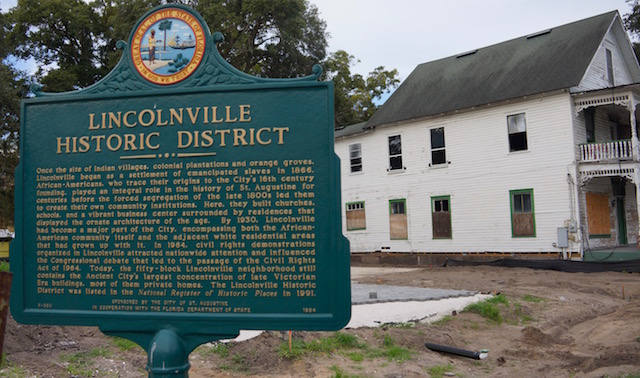By Katie Garwood and Courtney Cox | gargoyle@flagler.edu
In any community over time, buildings are renovated, streets get paved and repaved and trees grow. But in Lincolnville in St. Augustine, Florida, faces change.
The community remained mostly African American until the last decade, when the percentage of the white population skyrocketed. According to the U.S. Census, in 2000, Lincolnville was 42 percent white. Whereas in 2014, it was 75 percent white.
Lincolnville, formerly known as “Little Africa” to its residents, started as a freed slave haven in 1866. This year, it celebrated its 150-year anniversary, but with a vastly different looking population than when it first started.
The Rev. Ron Rawls of St. Paul’s AME Church, located on Martin Luther King Jr. Avenue in Lincolnville, has witnessed changes in the area since he arrived at the church in 2007.
“It’s a community in transition,” Rawls said. ”It’s just gentrified … this used to be a predominantly African-American community.”

Lincolnville was designated as a historic district in Nov. 1991.
Judith Seraphin, who moved to Lincolnville 12 years ago, said she has seen the faces of the community begin to diversify.
“The neighborhood is changing. It’s changing pridefully, in a wonderful way,” said Seraphin, president of the Lincolnville Neighborhood Association. “One hundred fifty years, there’s not a lot of neighborhoods that can say that. It’s exciting, and we love all of our history.”
Seraphin said the reason for the increasing diversification of Lincolnville is its prime location near downtown St. Augustine.
However, the gentrification of Lincolnville has boosted property values, resulting in higher taxes, which has forced some homeowners to relocate. The U.S. Census shows that in 2000, there were 797 African Americans in Lincolnville. In 2014, just 375.
“Many of us who have moved into Lincolnville moved in because we liked the diversity in the neighborhood,” Seraphin said. “What bothers many of us, and I know this because we talk about it, is the neighborhood is changing and is becoming so white and there’s so little diversity. Many times, when the older African American families die off, there won’t be anyone to replace them and it’ll be an all white neighborhood.”
Celebrating the community in the face of change
Despite the changes that the community has been through, residents who remain in Lincolnville, hope that recent gentrification doesn’t overshadow Lincolnville’s rich history.
In the 1960s, Lincolnville—like much of the South—became a hotspot for the civil rights era. Martin Luther King Jr. visited Lincolnville frequently to join non-violent protests, which played a part in the passing of the Civil Rights Act of 1964 and the Voting Rights Act of 1965.
And although the face of the community is changing, both long-timers and transplants, take great pride in living in Lincolnville.
“There’s just something about Lincolnville, and I don’t think anybody could describe it in words, it’s just a feeling,” Seraphin said. “You just want to live here, you just want to be part of it, want to make it better, want to contribute.”

Lincolnville residents march in the parade, which preceded the festival on Sept. 24.
One way the community continues to celebrate its legacy is through the Lincolnville Festival. In 2015, Rawls took over the festival, relocating it to Eddie Vickers Park. Each year, the festival donates a minimum of $1,000 to a local nonprofit organization. This year, the beneficiary was the Kid’s Safe Zone, a free after-school program for at-risk youth in West St. Augustine.

The 37th Annual Lincolnville Festival took place on Sept. 24–25, drawing between 2,500 and 4,000 people to Eddie Vickers Park.
Rawls said he wanted to ensure the annual festival continued for those in the Lincolnville community.
“For the people who have been here all of their lives, the Lincolnville Festival is something they look forward to,” he said.
To help pay for the festival, as well as celebrate Lincolnville’s history, a 150th birthday party was hosted at the Willie Gallimore Community Center in September. The party brought together residents who had been there all their lives and newcomers, both of whom appreciate Lincolnville’s history.
During the party, a timeline of Lincolnville’s history was revealed inside the Gallimore Center, showcasing how different eras shaped the community’s history.
“We just have to keep telling the story, so the story is not forgotten,” Rawls said.
Even after countless changes in the community over 150 years, many more will follow. According to Seraphin, most of those changes are still unknown, but she hopes they will make the community stronger.
“The ideas are endless, and people are excited because they live here,” she said. “And they just want it to get better … Lincolnville wants Lincolnville to get even better.”



Be the first to comment on "Despite gentrification, Lincolnville residents celebrate heritage, 150 years"